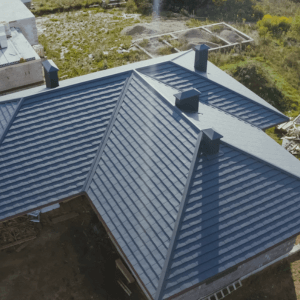It’s time to face the music, folks—roof types are one of the most critical components of your home. If you’ve ever had a leaky ceiling or found yourself standing under an unexpected drip during a rainstorm, you know just how important a good roof can be. The right roof type keeps your home safe from the weather, boosts its curb appeal, and helps save on energy costs while adding value.
But let’s be real. Things can get a bit overwhelming when choosing the perfect roof for your home. Do you go with classic asphalt shingles, or do you embrace the sleek look of metal roofing? Maybe you’re eyeing those gorgeous tiles that scream elegance. The options are plentiful, and each has its pros and cons. Don’t worry—I’m here to guide you through the maze of roofing choices so you can find the perfect fit for your home in Georgetown or Round Rock, Texas.
What’s Up Top: The Lowdown on Popular Roof Types
First things first, let’s break down the most common roof types you’ll encounter. Whether you’re planning a new build or considering a replacement, you should be familiar with these options:
- Asphalt Roofing
- Metal Roofing
- Tile Roofing
- Slate Roofing
- Flat Roofing
Climate, budget, durability, and aesthetics all play significant roles in your decision. Living in Texas, you need a roof that can withstand heat, rain, and the occasional hailstorm.
Roofing Showdown- Pros and Cons of Each Roof Type

1. Asphalt Roofing
Asphalt roofing shingles are classic and reliable. They’re affordable, easy to install, and come in a variety of colors and styles to suit any home aesthetic. For those looking for more eco-friendly and green roofing options, consider asphalt shingles made with a fiberglass mat, which can make it more durable and cut down on the environmental impact.
Pros:
- Cost-effective and widely available
- Good durability, typically lasting 15-30 years
- Easy to replace if damaged
Cons:
- Can be prone to damage from high winds and extreme temperatures
- Less eco-friendly compared to other options
In Georgetown, where temperatures can soar, asphalt roofing is a smart choice. Just make sure to choose high-quality shingles designed to handle heat!
2. Metal Roofing

If you’re looking for something that’s as tough as Texas, metal roofing is worth considering. These roofs are made from materials like steel, aluminum, and copper, making them great for anyone who wants a durable, modern look. Metal roofing can be a green roofing choice, bouncing sunlight away and cutting down on energy use.
Pros:
- Long-lasting, often exceeding 50 years
- Reflects sunlight, which can help reduce cooling costs
- Resilient against extreme weather conditions
Cons:
- Higher initial cost compared to asphalt shingles
- Can be noisy during rain or hail
Metal roofs are becoming increasingly popular in Round Rock, thanks to their ability to withstand severe storms and their energy-efficient properties. Plus, they give your home a sleek, contemporary edge.
3. Tile Roofing

When you think of tile roofing, you might picture a charming Mediterranean villa. Tile roofs offer a stunning aesthetic and are incredibly durable, making them an excellent choice for hip roofs that add character to your home.
Pros:
- Exceptional longevity, often lasting over 50 years
- Naturally fire-resistant and energy-efficient
- A unique look that enhances curb appeal
Cons:
- Heavier than other materials, requiring additional structural support
- More expensive upfront
Tile roofing is a great option if you’re in neighborhoods around Liberty Hill that value distinct architectural styles. Just be prepared for that extra investment!
4. Slate Roofing

Slate roofs are the crème de la crème of roofing materials. This is the most elegant and durable.
Pros:
- Extremely long-lasting, with lifespans of over 100 years
- Beautiful natural stone appearance
- Fire-resistant and low-maintenance
Cons:
- Higher initial cost
- Requires professional installation because of the weight
Slate might not be the most common choice in Williamson county, but if you’re looking for something that screams sophistication, this is it. Just make sure your home can support the weight!
5. Flat Roofing

Flat roofs are often seen on commercial buildings, but they can work for residential homes, too. They offer a unique space that can double as a patio or garden area. One popular type of flat roofing is built-up roofing (BUR), which consists of multiple layers of roofing felt and asphalt. People love flat roofs because they’re durable and resistant to moisture.
Pros:
- Easy to install and maintain
- Provides additional usable outdoor space
- Typically less expensive than pitched roofs
Cons:
- More prone to water pooling, which can lead to leaks
- Shorter lifespan compared to sloped roofs
Flat roofs are an excellent option for modern homes with a rooftop garden or lounge area. Additionally, synthetic rubber flat roofing systems are gaining popularity thanks to their lightweight nature and eco-friendly attributes.
Before You Decide, Consider the Following-
Climate and Weather Resistance
In Texas, you need a roof that can stand up to the intense heat, rain, and occasional hail. Make sure you choose a material designed for our local weather patterns.
Cost and Budget
Be realistic about your budget. While some roofs cost less initially, think about how long they’ll last and what maintenance will cost down the road when you’re making your choice.
Aesthetic Appeal
Your roof can significantly impact your home’s overall look. Think about the architectural style of your home and choose a roof type that complements it.
Energy Efficiency
Roof types vary in their energy efficiency. Metal and tile roofs often reflect heat and UV rays better than asphalt shingles, which can help reduce your cooling costs. (Read more from Energy Star about Cool roofs.)
Roof Maintenance Tips That’ll Extend The Life of Your Roof
Maintenance Requirements
Keep up with roof maintenance to make it last longer. Here’s a quick rundown of what to watch for with various roofing materials:
- Asphalt Roofing: Inspect at least twice a year for loose or missing shingles and clean out gutters to prevent water pooling.
- Metal Roofing: Check for rust around seams and fasteners. A simple wash with soap and water can keep it looking great.
- Tile and Slate Roofing: These are fragile, so hire a professional for inspections. Look for cracked or loose tiles and keep gutters clear.
- Flat Roofing: Regularly check for pooling water and debris accumulation. Install drainage systems for better water flow.
Signs of Wear and When to Replace
Stay proactive by watching for these signs:
- Curling Shingles: Indicates aging or heat damage; they may need replacing.
- Missing Shingles: Can expose your roof to leaks and pests; replace them promptly.
- Water Stains on Ceilings: A clear indicator of roof issues—investigate leaks immediately.
- Granule Loss: Finding a bunch of granules in your gutters means your shingles are wearing out.
- Mold or Moss Growth: Tackle moisture issues right away to prevent further damage.
- Increased Energy Bills: This could mean damaged roofing materials are hurting your insulation.
Your Roofing Repair and Replacement Roadmap Awaits
At CK Restoration, we’re here to help you every step of the way. Our veteran-led team keeps a close eye on every detail, whether it’s for roof inspections, consultations, or new installations. If you’re ready to explore your roofing options or have questions, don’t hesitate to reach out!
Let’s Get You Covered
Ready to elevate your home with the right roof? Contact CK Restoration today to schedule your free consultation! Our roofing contractors will check out what you need, go over your options, and help you pick the perfect roof for your home and budget. Don’t wait—let’s get started on your roof project together!

